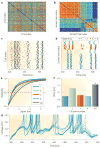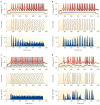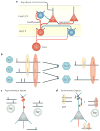Regulation of spike timing in visual cortical circuits
- PMID: 18200026
- PMCID: PMC2868969
- DOI: 10.1038/nrn2315
Regulation of spike timing in visual cortical circuits
Abstract
A train of action potentials (a spike train) can carry information in both the average firing rate and the pattern of spikes in the train. But can such a spike-pattern code be supported by cortical circuits? Neurons in vitro produce a spike pattern in response to the injection of a fluctuating current. However, cortical neurons in vivo are modulated by local oscillatory neuronal activity and by top-down inputs. In a cortical circuit, precise spike patterns thus reflect the interaction between internally generated activity and sensory information encoded by input spike trains. We review the evidence for precise and reliable spike timing in the cortex and discuss its computational role.
Figures








Similar articles
-
A computational model as neurodecoder based on synchronous oscillation in the visual cortex.Neural Comput. 2003 Oct;15(10):2399-418. doi: 10.1162/089976603322362419. Neural Comput. 2003. PMID: 14511527
-
Gamma-phase shifting in awake monkey visual cortex.J Neurosci. 2010 Jan 27;30(4):1250-7. doi: 10.1523/JNEUROSCI.1623-09.2010. J Neurosci. 2010. PMID: 20107053 Free PMC article.
-
Feedforward Thalamocortical Connectivity Preserves Stimulus Timing Information in Sensory Pathways.J Neurosci. 2019 Sep 25;39(39):7674-7688. doi: 10.1523/JNEUROSCI.3165-17.2019. Epub 2019 Jul 3. J Neurosci. 2019. PMID: 31270157 Free PMC article.
-
Dynamic properties of thalamic neurons for vision.Prog Brain Res. 2005;149:83-90. doi: 10.1016/S0079-6123(05)49007-X. Prog Brain Res. 2005. PMID: 16226578 Review.
-
Static and dynamic views of visual cortical organization.Prog Brain Res. 2002;136:389-408. doi: 10.1016/s0079-6123(02)36032-1. Prog Brain Res. 2002. PMID: 12143396 Review.
Cited by
-
Analysis of spontaneous activity of superficial dorsal horn neurons in vitro: neuropathy-induced changes.Pflugers Arch. 2016 Nov;468(11-12):2017-2030. doi: 10.1007/s00424-016-1886-6. Epub 2016 Oct 10. Pflugers Arch. 2016. PMID: 27726011
-
Endogenous sequential cortical activity evoked by visual stimuli.J Neurosci. 2015 Jun 10;35(23):8813-28. doi: 10.1523/JNEUROSCI.5214-14.2015. J Neurosci. 2015. PMID: 26063915 Free PMC article.
-
Adaptive spike-artifact removal from local field potentials uncovers prominent beta and gamma band neuronal synchronization.J Neurosci Methods. 2020 Jan 15;330:108485. doi: 10.1016/j.jneumeth.2019.108485. Epub 2019 Nov 6. J Neurosci Methods. 2020. PMID: 31705936 Free PMC article.
-
Variability of visual responses of superior colliculus neurons depends on stimulus velocity.J Neurosci. 2010 Mar 3;30(9):3199-209. doi: 10.1523/JNEUROSCI.3250-09.2010. J Neurosci. 2010. PMID: 20203179 Free PMC article.
-
How synchronization protects from noise.PLoS Comput Biol. 2010 Jan 15;6(1):e1000637. doi: 10.1371/journal.pcbi.1000637. PLoS Comput Biol. 2010. PMID: 20090826 Free PMC article.
References
-
- Mainen Z, Sejnowski T. Reliability of spike timing in neocortical neurons. Science. 1995;268:1503–1506. - PubMed
-
- Liu RC, Tzonev S, Rebrik S, Miller KD. Variability and information in a neural code of the cat lateral geniculate nucleus. J Neurophysiol. 2001;86:2789–2806. - PubMed
-
- Butts DA, et al. Temporal precision in the neural code and the timescales of natural vision. Nature. 2007;449:92–95. - PubMed
Publication types
MeSH terms
Grants and funding
LinkOut - more resources
Full Text Sources

